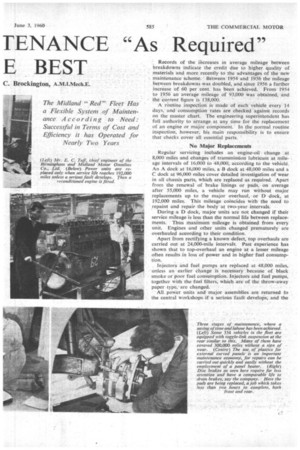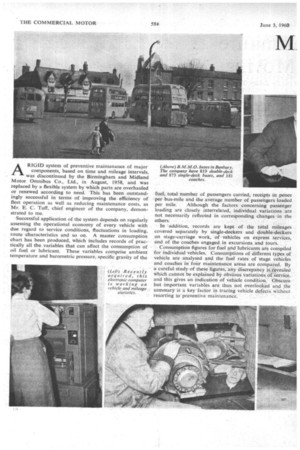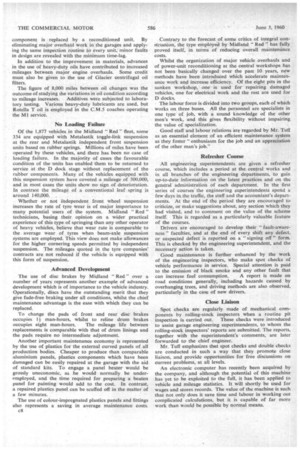TENANCE "As Required" E BEST
Page 57

Page 56

Page 58

If you've noticed an error in this article please click here to report it so we can fix it.
ARIGID system of preventive maintenance of major components, based on time and mileage intervals, was discontinued by the Birmingham and Midland Motor Omnibus Co., Ltd., in August, 1958, and was replaced by a flexible system by which parts are overhauled or renewed according to need. This has been outstandingly successful in terms of improving the efficiency of fleet operation as well as reducing maintenance costs, as Mr. E. C. Tuff, chief engineer of the company, demonstrated to me. .
Successful application of the system depends on regularly assessing the operational economy of every vehicle with due regard to service conditions, fluctuations in loading, route -characteristics and so on. A master consumption chart has been produced, which includes records of Practically all the variables that canaffect the consumption of oil fuel or lubricant. These variables comprise ambient temperature and barometric pressure, specific gravity of the
fuel, total number of passengers carried, receipts in pence per bus-mile and the average number of passengers loaded per mile. Although the factors concerning passenger loading are closely interrelated, individual variations are not necessarily reflected in corresponding changes in the others.
In addition, records are kept of the total mileages covered separately by single-deckers and double-deckers on stage-carriage work, of vehicles on express services, and of the coaches engaged in excnrsions and tours.
Consumption figures for fuel and lubricants are compiled for individual vehicles. Consumptions of different types of vehicle are analysed and the fuel rates of stage vehicles and coaches in fourmaintenance areas are compared. By a careful study of these figures, any discrepancy is revealed which cannot be explained by obvious Variations of service. and this gives an indication of vehicle condition. Obscure but important variables are thus not overlooked and the summary is a key factor in tracing vehicle defects without resorting to`preventive maintenance. Records of the increases in average mileage between breakdowns -indicate the credit due to higher quality of materials and more recently to the advantages of the• new maintenance scheme: Between 1954 and 1956 the Mileage between breakdowns was doubled, and since 1956 a further increase of 60 per cent, has been achieved. From 1-954 to 1956 an average mileage of 93,000 was obtained, and
• the current figure is 138,000.
A rOutine inspection is made of each vehicle every 14 days, and consumption rates are checked against records on the master chart. The engineering superintendent has full authority to arrange at any time for the replacement of an engine or major component. In the normal routine inspection, however, his main responsibility is to ensure that checks cover all essential parts.
No Major Replacements • Regular servicing includes an engine-oil change at 8,000 miles and changes of tiansmission lubricant at mileage intervals of 16,000 to 48,000, according to the vehicle. An A dock at 16,000 miles, a B dock at 48,000 miles and a C dock at 96,000 miles cover detailed investigation of wear in all chassis parts, which are replaced as required. Apart from the renewal of brake linings or pads, on average
after 55,000 miles, a vehicle may run without major replacements up to the major overhaul,or D dock, at 192,000 miles. This mileage coincides with the need to repaint and repair the• body at two-year. intervals.
During a D dock, major units are not changed if their service mileage is less than the normal life between replacements. Thus Maximum mileage is obtained from • every. unit. Engines and other units changed prematurely are overhauled according to their condition.
Apart from rectifying a known defect, top overhauls are carried out at 24,000-mile intervals. Past experience has shown that to top-overhaul an engine at a lesser mileage often results in loss of power and in higher fuel consumption.
Injectors and fuel pumps are replaced at 48,000 miles, unless an earlier change is necessary because of black smoke or poor fuel consumption. Injectors and fuel pumps, together with the fuel filters, which are of the throw-away paper type,are changed.
• All power units and major assemblies are returned to the central workshops if a serious fault develoPs, and the component is replaced by a reconditioned unit. By eliminating major overhaul work in the garages and applying the same inspection routine to every unit, minor faults in design are revealed with the minimum time-lag.
In addition to the improvement in materials, advances in the use of heavy-duty oils have contributed to increased mileages between major engine overhauls. Some credit must also be given to the use of Glacier centrifugal oil filters.
The figure of 8,000 miles between oil changes was the outcome of studying the variations in oil condition according to mileage increases. Additives were subjected to laboratory testing. Various heavy-duty lubricants are used, but Rotella T oil is employed in the C.M.5 coaches operating the MI service.
No Loading Failure Of the 1,877 vehicles in the Midland " Red " fleet, some 334 are equipped with Metalastik toggle-link suspension at the rear and Metalastik independent front suspension units based on rubber springs. Millions of miles have been operated by these vehicles, and there has been no case of loading failure. In the majority of cases the favourable condition of the units has enabled them to be returned to service at the D dock stage without replacement of the rubber components. Many of the vehicles equipped with this suspension system have covered a mileage of 300,000, and in most cases the units show no sign of deterioration. In contrast the mileage of a conventional leaf spring is• around 140,000.
Whether or not independent front wheel suspension increases the rate of tyre wear is of major importance to many potential users of the system. Midland " Red" technicians, basing their opinion on a wider practical experience of this type of springing than any other operator of heavy vehicles, believe that wear rate is comparable to the average wear of tyres when beam-axle suspension systems are employed. This view does not make allowances for the higher cornering speeds permitted by independent suspension. The mileages quoted in the tyre companies' contracts are not reduced if the vehicle is equipped with this form of suspension.
Advanced Development
The use of disc brakes by Midland " Red " over a number of years represents another example of advanced development which is of importance to the vehicle industry. Operationally, discs have the outstanding merit that they give fade-free braking under all conditions, whilst the chief maintenance advantage is the ease with which they can be replaced.
To change the pads of front and rear disc brakes occupies 11 man-hours, whilst to reline drum brakes occupies eight man-hours. The mileage life between replacements is comparable with that of drum linings and the pads require no intermediate adjustment.
Another important maintenance economy is represented by the use of plastics for the external curved panels of. all production bodies. Cheaper to produce than comparable aluminium panels, plastics components which have been damaged can be easily repaired at the garage with the aid of standard kits. To engage a panel beater would be grossly uneconomic, as he would normally be underemployed, and the time required for preparing a beaten panel for painting would add to the cost. In contrast, a repaired plastics panel can be scuffed off in the matter of a few minutes.
The use of colour-impregnated plastics panels and fittings also represents a saving in average maintenance costs. c8 Contrary to the forecast of some critics of integral construction, the type employed by Midland " Red " has fully proved itself, in terms of reducing overall maintenance costs.
Whilst the organization of major vehicle overhauls and of power-unit reconditioning at the central workshops has not been basically changed over the past 10 years, new methods have been introduced which accelerate maintenance work and increase efficiency. Of the eight pits in the sunken workshop, one is used for repairing damaged vehicles, one for electrical work and the rest are used for D docks.
• The labour force is divided into two groups, each of which works on three buses. All the personnel are specialists in one type of job, with a soundknowledge of the other men's work, and this gives flexibility without impairing the value of specialization.
Good staff and labour relations -are regarded by Mr. Tuff as an essential element of an efficient maintenance system as they foster "enthusiasm for the job and an appreciation of the other man's job."
Refresher Course
All engineering superintendents are given a refresher course, which includes a period at the central works and in all branches of the engineering departments, to gain up-to-date information on the latest practices and on thc general administration of each department. In the first series of courses the engineering superintendents spend a few days in. the traffic, the staff and the accountant's departments. At the end of the period they are encouraged to criticize, or make suggestions about, any section which they had visited, and to comment on the value of the scheme itself. This is regarded as a particularly valuable feature of the courses.
Drivers are encouraged to develop their " fault-awareness " faculties, and at the end of every shift any defect, or suspected defect is reported on a "signing off" form. This is checked by the engineering superintendent, and the necessary action is taken.
Good maintenance is further enhanced by the work of the engineering inspectors, who make spot checks of vehicle performance in service. Special attention is paid to the emission of black smoke and any other fault that can increase fuel consumption. A report is made on road conditions generally, including hazards caused by overhanging trees, and driving methods are also observed, particularly in the case of new drivers.
Close Liaison
Spot checks are regularly made of mechanical components by rolling-stock inspectors when a routine pit inspection is carried out. These checks were introduced to assist garage engineering superintendents, to whom the rolling-stock inspectors' reports are submitted. The reports, together with the superintendent's comments, are later forwarded to the chief engineer.
Mr. Tuff emphasizes that spot checks and double checks are conducted in such a way that they promote close liaison, and provide opportunities for free discussions on current problems, at all levels.
An electronic computer has recently been acquired by the company, and although the potential of this machine has yet to be exploited to the full, it has been applied to vehicle and mileage statistics. It will shortly be used for wages and stores records. The value of the machine is such that not only does it save time and labour in working out complicated calculations, but it is capable of far more work than would be possible by normal means.
















































































































